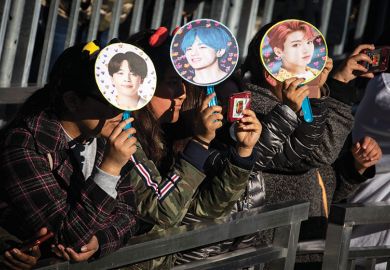Indian film-makers and other industry personnel talk confidently about the cinema audience, yet they seem increasingly unable to produce films that are sure to attract moviegoers.
The audience is an object worthy of scrutiny in the study of western popular culture yet, despite the many anthropologists researching Indian cinema, ethnographic studies of Indian cinema's audiences are even rarer than hit films. The only substantial ethnography is Sara Dickey's study of filmgoers in Madurai, Cinema and the Urban Poor (1993), based on fieldwork that is now nearly a decade old.
The title and subtitle of Steve Derne's book promise to deliver a timely study, but the book goes only some way towards achieving its aims. The fieldwork is based on research carried out in 1987 and 1991, before seismic changes transformed Indian public culture through the advent of transnational television, changes in cinema-going practices, a boom in advertising and economic liberalisation.
Nevertheless, a study of the period immediately preceding this revolution has appeal. Derne has looked at two interesting cities, Banaras and Dehra Dun, rather than the usual metropolises. His aims are: to examine celebrations of individuality in the context of ideas about modernity and masculinity; to study Indian ways of thinking; to make an ethnographic study of a male audience in cinema halls; and to look at how cinema-going produces a national identity as well as those structured around gender and class.
I have no quarrel with the limited audience sample, as there is no such thing as a representative ethnography. My disquiet is with Derne's acceptance of all discourses at face value, as facts. I find it strange that he believes that the audience is so deeply ambivalent about the films. Could it be that the interviewees are telling a foreigner what they think he wants to hear, namely the films are not realistic and hence of little value? Are the kind of people interviewed able to articulate their pleasure in cinema-going, or should their words be presented more fully to allow the reader, if not the ethnographer, to interpret them? The informants are presented as statistics. Perhaps a lack of intimacy or empathy has made the interviewees feel unable to talk freely about illicit pleasures in cinema-going, such as sexual excitement and homoeroticism.
While I welcome the book's ethnographic approach, it is clear that it needs to be supplemented with readings from other disciplines, in particular film studies and textual analysis. Derne feels that he has found new material in his section about the male body as the object of the cinematic gaze, but this has been much discussed in film theory. He seems to have overlooked writing by scholars such as Prasad, Rajadhyaksha and Vasudevan about cinema and politics, economics, film history and textual analysis of Indian cinema. He has ignored key works, such as Richard Dyer's studies of entertainment and of stars in the context of Hollywood, which have been examined in the light of Indian cinema. These would have led to more subtle readings of films and audience responses, rather than this inventory of unproblematised fact.
There is some fascinating material for analysis here. For example, Derne often gives the Hindi terms used alongside his translations of dialogues and audience responses. These could produce rich findings about discourses of modernity and of masculinity, illuminating the rich film language this cinema has generated. But that task awaits another author.
Rachel Dwyer is senior lecturer in Indian studies, School of Oriental and African Studies, University of London.
Movies, Masculinity and Modernity: An Ethnography of Men's Filmgoing in India
Author - Steve Derne
ISBN - 0 313 31287 7
Publisher - Greenwood Press
Price - £40.95
Pages - 212
